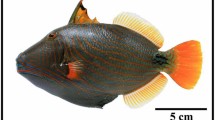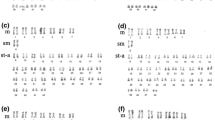Abstract
Information about evolutionary relationships between species of the genusAllium is desirable in order to facilitate breeding programmes. One approach is to study the distribution of repetitive DNA sequences among species thought on taxonomic grounds, to be closely related. We have used fluorescent in-situ hybridisation (FISH) to examine seven species within sect.Cepa of the genus (A. altaicum, A. cepa, A. fistulosum, A. galanthum, A. pskemense, A. oschaninii andA. vavilovii), one species from sect.Rhizirideum (A. roylei), two species from sect.Allium (A. sativum andA. porrum) and one species from sect.Schoenoprasum (A. schoenoprasum). Each species was probed using a 375 bp repeat sequence isolated fromA. cepa (Barnes & al. 1985), which was generated and labelled by polymerase chain reaction (PCR). No signals were detected in anyAllium species not belonging to sect.Cepa with the exception ofA. roylei, whose designation in sect.Rhizirideum is now questioned. Within sect.Cepa the probe was found to hybridize to the ‘terminal’ regions of the chromosome arms of all the species examined. In addition a number of interstitial bands were detected. Use of FISH reveals a more detailed map of the location of the repeat sequences than has previously been obtained by C-banding and other staining procedures. The distribution of the terminal and interstitial sites when compared, allow us to identify three species groups namely,A. altaicum andA. fistulosum; A. cepa, A. roylei, A. oschaninii andA. vavilovii; andA. galanthum andA. pskemense.
Similar content being viewed by others
References
Anamthawat-Jónsson, K., Heslop-Harrison, J. S., 1993: Isolation and characterization of genome-specific DNA sequences inTriticeae species. — Molec. Gen. Genet.240: 151–158.
Armstrong, S. J., 1992: Chromosome staining techniques and interspecific hybridization in the genusAllium, sectionsCepa Miller (Prokh.) andSchoenoprasum (Dumort.). — Ph.D Thesis, University of Birmingham.
Barnes, S. R., James, A. M., Jamieson, G., 1985: The organization, nucleotide sequence and chromosomal distribution of a satellite DNA fromAllium cepa. — Chromosoma92: 185–192.
Bedbrook, J. R., Jones, J., O'Dell, M., Thompson, R. D., Flavell, R. B., 1980: A molecular description of telomeric heterochromatin inSecale species — Cell19: 545–560.
Biessmann, H., Mason, J. M., 1990: Chromosome ends inDrosophila without telomeric DNA sequences. — Proc. Natl. Acad. Sci. USA87: 1758–1761.
de Vries, J. N., 1990: Onion chromosome nomenclature and homeology relationships — workshop report. — Euphytica49: 1–3.
-Jongerius, M. C., 1988: Interstitial C-bands on the chromosomes ofAllium species from sectionCeba. — Proceedings of the Fourth EUCARPIA Allium Symposium, Warwick, pp. 71–78.
—, 1992: Introgression of leaf blight fromAllium roylei Stearn into onion (A. cepa L.). — Euphytica62: 127–133.
El-Gadi, A., Elkington, T. T., 1975: Comparison of the Giemsa C-band karyotypes and the relationships ofAllium cepa, A. fistulosum andA. galanthum. — Chromosoma51: 19–23.
Hanelt, P., 1990: Taxonomy, evolution, and history. — InRabinowitch, H. D., Brewster, J. L., (Eds): Onions and allied crops.1 pp. 1–26. — Boca Raton, FL.: CRC Press.
Havey, M. J., 1992: Restriction enzyme analysis of the chloroplast and nuclear 45s ribosomal DNA ofAllium sectionsCepa andPhyllodolon (Alliaceae). — Pl. Syst. Evol.183: 17–31.
Inada, I., Endo, M., 1994: C-banded karyotype analysis ofAllium fistulosum andA. altaicum and their phylogenetic relationship. — J. Jap. Soc. Hort. Sci.63: 593–602.
Irifune, K., Hiria, K., Zheng, J., Tanaka, R., 1995: Nucleotide sequence of a highly repeated DNA sequence and its chromosomal localization inAllium fistulosum. — Theor. Appl. Genet.90: 312–316.
Jiang, J. M., Gill., B. A., 1994: New 18S. 26S ribosomal RNA gene loci: — chromosomal landmarks for the evolution of polyploid wheats., Chromosoma103: 179–185.
Jones, R. N., 1991: Cytogenetics of Alliums. — InTsuchiya, T., Gupta, P. K., (Eds): Chromosome engineering in plants, pp. 215—227.
Kalkman, J., 1984: Analysis of the C-band karyotype ofAllium cepa L. Standard system of nomenclature and polymorphism. — Genetica65: 141–148.
Lapitan, N. L. V., Ganal, M. W., Tanksley, S. D., 1989: Somatic chromosome karyotype of tomato based on in situ hybridization of the TGR 1 satellite repeat. — Genome32: 992–998.
McCollum, G. D., 1982: Experimental hybrids betweenAllium fistulosum andAllium roylei. — Bot. Gaz.143: 238–243.
Pich, U., Schubert, I., 1993: Polymorphism of Legumin genes in inbred lines ofVicia faba. — Biol. Zentralbl.112: 342–350.
—, 1996a: Closely relatedAllium species (Alliaceae) share a very similar satellite sequence. — Pl. Syst. Evol.202: 255–264.
—, 1996b: How doAlliaceae stabilize their chromosome ends in the absence of TTTAGGG sequences? — Chromosome Res.4: 207–213.
Rayburn, A. L., Gill, B. S., 1987: Molecular analysis of the D-genome of theTriticeae. — Theor. Appl. Genet.73: 385–388.
Röder, M. S., Lapitan, N. L. V., Sorrells, M. E., Tanksley, S. D., 1993: Genetic and physical mapping of barley telomeres. — Molec. Gen. Genet.238: 294–302.
van der Meer, Q. P., de Vries, J. N., 1990: An interspecific cross betweenAllium roylei Stearn andAllium cepa L., and it's backcross toA. cepa. — Euphytica47: 29–31.
van Raamsdonk, L. W. D., Wietsma, W. A., de Vries, J. N., 1992: Crossing experiments inAllium L. sectionCepa. — Bot. J. Linn. Soc.109: 293–303.
Smiech, M. P., Sandbrink, J. M., 1997: Introgression explains incongruence between nuclear and chloroplast DNA-based phylogenies inAllium sectionCepa. — Bot. J. Linn. Soc.123: 91–108.
Vosa, C. G., 1976: Heterochromatic patterns inAllium. — Heredity36: 383–392.
Wu, K. S., Tanksley, S. T., 1993: Genetic and physical mapping of telomeres and macrosatellites of rice. — Pl. Molec.22: 861–872.
Author information
Authors and Affiliations
Rights and permissions
About this article
Cite this article
Stevenson, M., Armstrong, S.J., Jones, G.H. et al. Distribution of a 375 bp repeat sequence inAllium (Alliaceae) as revealed by FISH. Pl Syst Evol 217, 31–42 (1999). https://doi.org/10.1007/BF00984920
Received:
Revised:
Accepted:
Issue Date:
DOI: https://doi.org/10.1007/BF00984920




